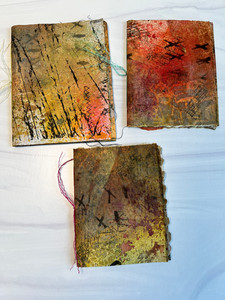Beginner Bookbinding: Why I Fell in Love with Handmade Books
- Melanie Grant

- Jul 7
- 2 min read
Updated: Jul 11
By Melanie Grant
A Craft Worth Falling For
There’s something special about making a book with your own hands.
The texture of the paper, the rhythm of stitching, the slow transformation of loose sheets into something meaningful—it’s a practice that connects you to craft, history, and yourself.
When I first started, I didn’t have formal training. I just had a deep desire to make something beautiful and lasting. Maybe that’s where you are, too.
Let me tell you this: You don’t need a certificate to be a bookbinder. You just need some good instruction which is available online, in books as well as possible, local workshops in your area.

What Is Bookbinding?
At its most basic, bookbinding is the process of gathering pages and securing them into a single volume. That’s it. It can be as simple as folding paper and sewing through the spine—or as intricate as Japanese stab bindings, Secret Belgian bookbinding and French link stitches. There’s room for everyone here, no matter your experience.
Why I Fell in Love with Bookbinding
I came to bookbinding as an artist—drawn in by the tactile satisfaction of it all. Every step requires your attention and care. It’s a slow craft in the best way. I love that you don’t need a pile of fancy tools to begin. Some of my earliest books were wonky and imperfect. They told a story of where I was creatively at the time. Bookbinding is both grounding and expressive. It invites experimentation and reflection.
Getting Started: Tools You Actually Need
You’ve probably read posts filled with long supply lists and affiliate links. That’s not what this is.
Let me give it to you straight: To start making books, you just need paper.
Yes, really. Fold a stack, sew a spine—that’s a book. But if you want to try something more refined (like a cloth-covered journal), here’s what I recommend:
Starter Materials
Paper (Try a 9×12 spiral-bound pad of 60 lb/90 gsm drawing paper)
Glue (Elmer’s Glue or Glue Stick is fine for starters) PVA
Linen thread (optional but helpful)
Cardstock paper (12×12 scrapbooking sheets make great covers)
Starter Tools
Sewing needle
Utility knife
12"–18" ruler
Scissors
Something heavy to press the book as it dries
Optional (but handy):
Foam brush for glue or a glue brush
Awl or thick needle for piercing paper
Bone folder
Binding Methods for Beginners
Here are the three techniques I recommend for getting started. They’re simple, fast, and use minimal tools:
Pamphlet Binding
French Link Stitch
Japanese Stab Binding
These methods teach you how paper, thread, and structure come together to form a book.
📖 Try these beginner tutorials:
A Few Encouraging Words
Bookbinding has been practiced for thousands of years. But that doesn’t mean it’s only for professionals.
You don’t need permission or perfection to begin. Choose paper that feels good in your hands. Let your first books be experiments—messy and joyful.
Remember: You’re not recreating a medieval manuscript. You’re making something with your own hands, your own voice, and your own vision.
That’s the real magic.
✨ Ready to Start?
Thank you for letting me be part of your journey.Happy binding.—Melanie












Thank you Hilde, it is addictive....but a lot of fun.
It sounds like it is addictive!
I think I'll try some of these but first let me get one from your shop! Thanks for the links and the encouraging words.